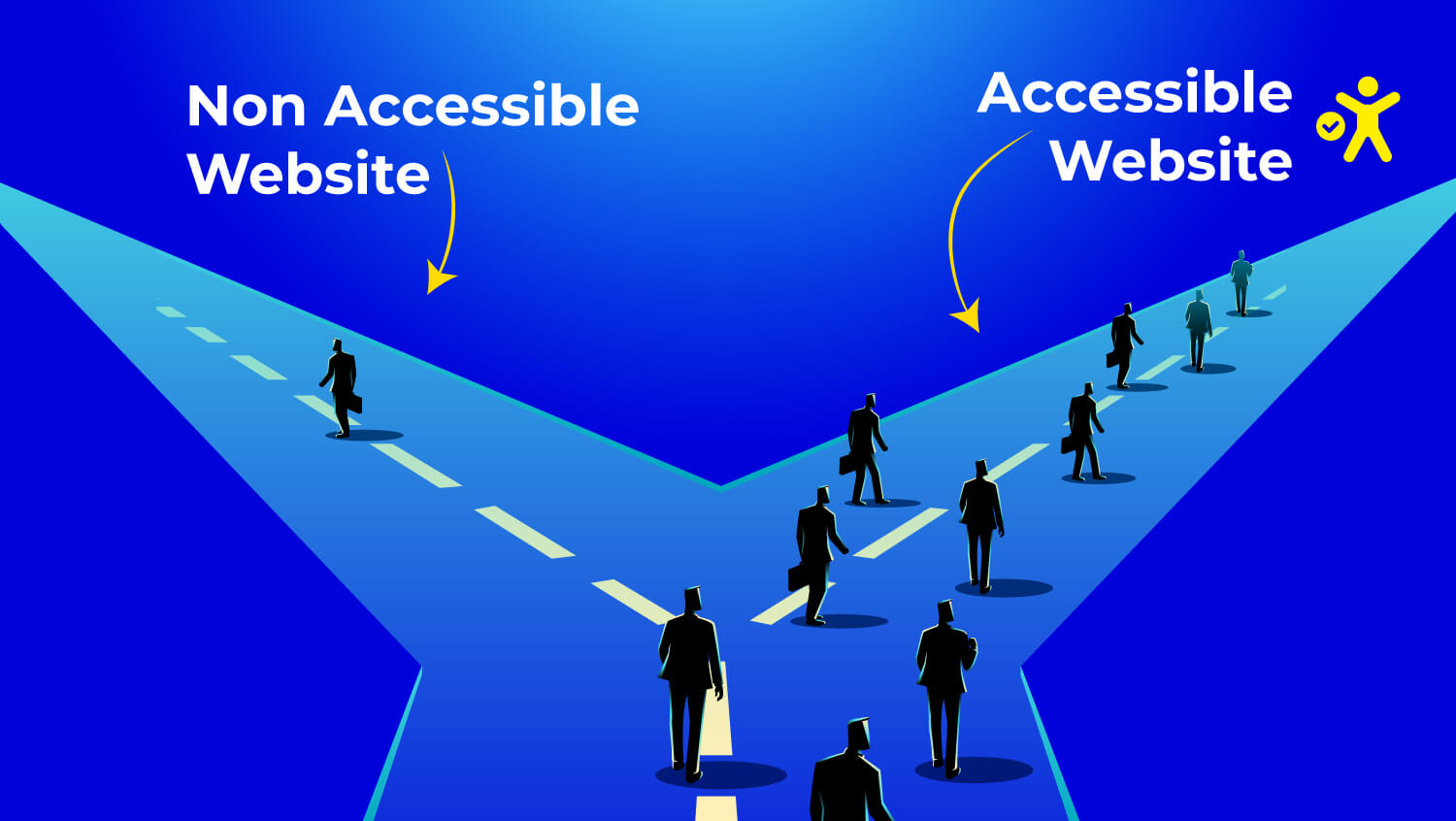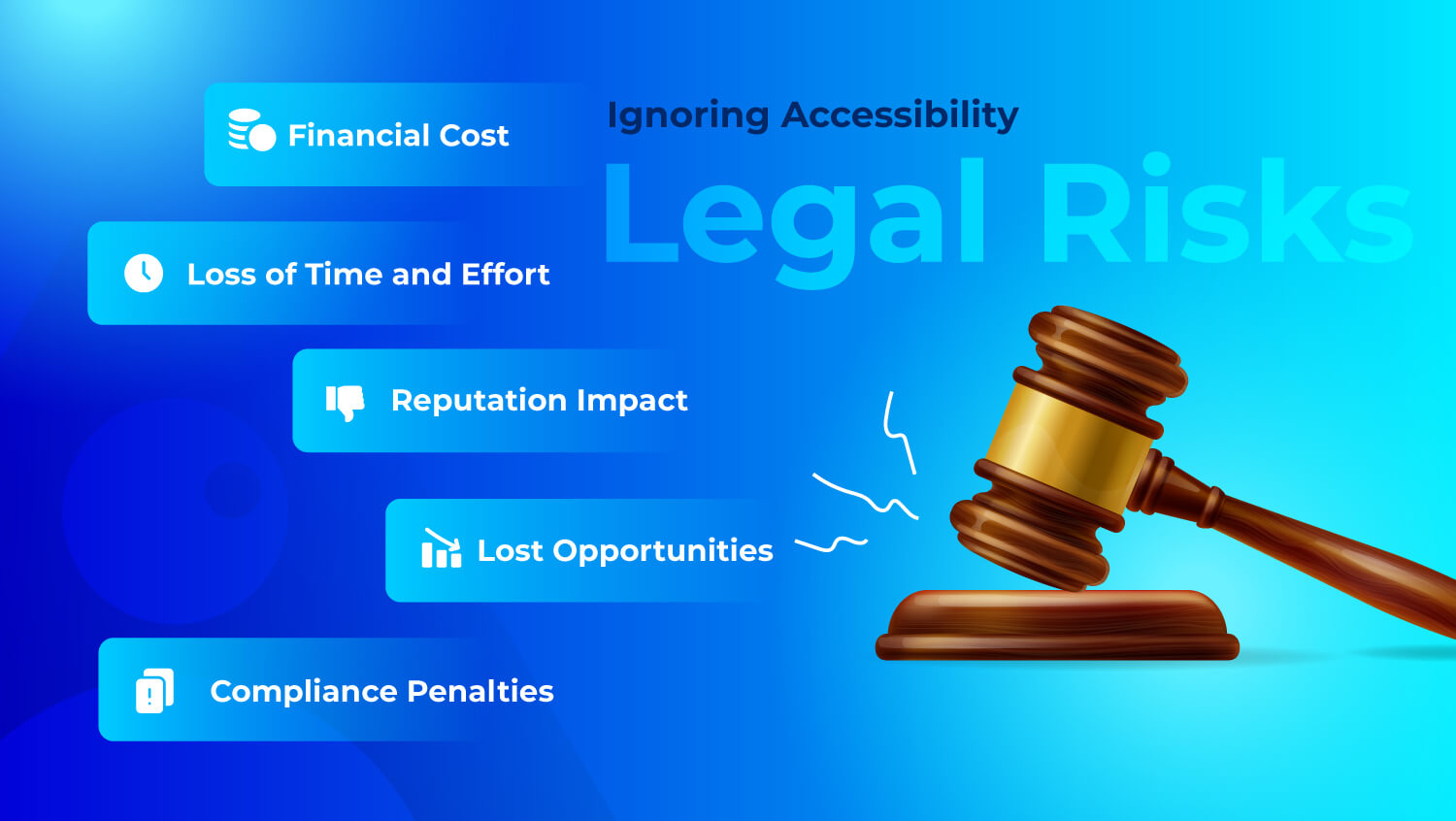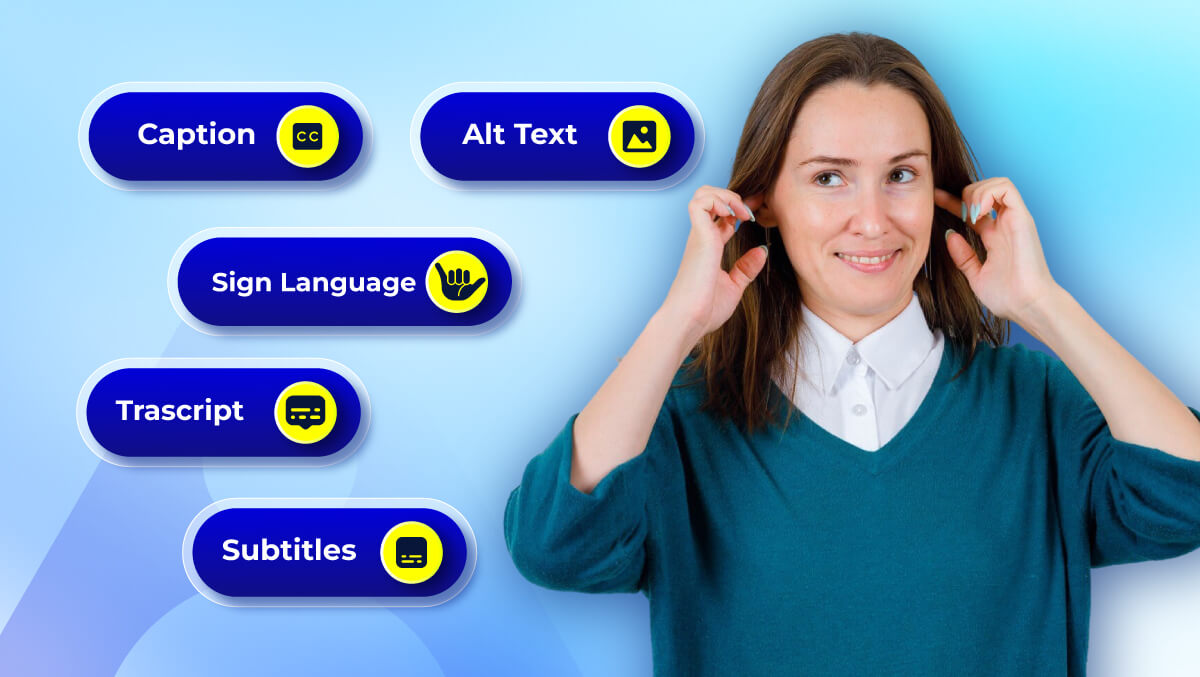What Is Cognitive Accessibility?
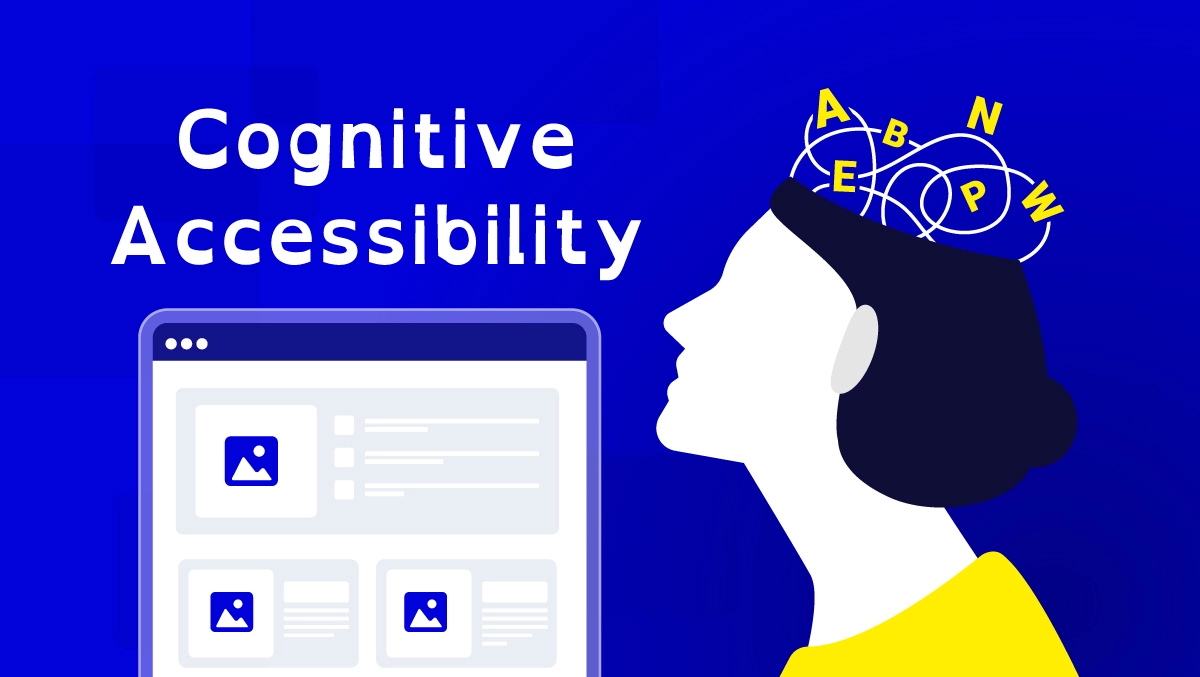
Cognitive disability happens when the loss of information, processing, or use creates challenges for the person experiencing the cognitive impairment. Often, this is something you can't see by looking at someone, but it can affect their daily lives in meaningful ways.
In the US, more than 1 in 4 adults in the US have a disability. That's more than 70 million people, and almost 14% struggle with remembering, focusing, or making decisions that fall under the definition of cognitive impairment.
These statistics represent real people, colleagues, friends, or family who can feel excluded from website content when the website is confusing, too fast-paced, or if they are unable to navigate the website.
So, let's talk a little more about what cognitive disability is!
What is Cognitive Disability?
Cognitive disabilities affect the brain's ability to process information. They may impact how a person learns new things, retains new facts, and organizes their thoughts to solve a problem and comprehend what they hear or read.
It may have effects on memory or learning, everyday problem solving, attention or focus, and/or may be lifelong. For some people, cognitive changes may occur as the result of an illness such as a stroke, or changes in cognition may occur as a natural part of aging.
Cognitive impairments may vary in impact and severity. It might exist from birth, in some cases can develop over time, or due to health issues, or be the result of an illness or injury.
Categories of cognitive disabilities:
Intellectual disabilities:
- People who have some limitations with learning, reasoning, problem solving, and daily self-sufficiency and adaptation.
- Examples of these forms of disabilities include Down syndrome, developmental delays, and long-term effects due to a traumatic brain injury.
- Globally, it is estimated that about 2-3% of the population have some form of intellectual disability, but we do not address many of these needs.
Mental health conditions with cognitive impairments:
- There are mental illnesses where cognitive impairments are a real issue.
- Individuals with illnesses like schizophrenia, major depression, and PTSD struggle to think, pay attention, and process information in any coherent way.
Aging-related conditions:
- Among the aging population, there is still the potential to get dementia, Alzheimer's disease, or aphasia.
- All these conditions greatly affect people's ability to remember things, communicate, and/or execute step-wise planned tasks.
Learning and behavioral differences:
- Conditions like ADHD, dyslexia, and dyscalculia can make specific tasks, like paying attention, reading, or working with numbers, more difficult.
We should remember that everyone is unique. Two people with the same diagnosis might face two very different challenges.
What Is Cognitive Accessibility?
Cognitive accessibility is about designing things, in particular, websites and digital tools, where different ways of thinking, remembering, or learning, have less friction using the things we make.
It’s about getting rid of confusion, reducing unnecessary complexity, and providing clarity for all product users. Creating simpler content does not mean it is less valuable content.
In fact, by lowering the complexity, we reduce the barriers to understanding for all users, whether it is a busy parent scanning on a phone, a student acquiring English language, or someone operating a website at the end of their work day.
At its heart, cognitive accessibility is about respect. It is recognition that “your time, focus, and energy counts” and, we want to try and enable you to get what you want and need without the added struggle.
Common Cognitive Accessibility Challenges
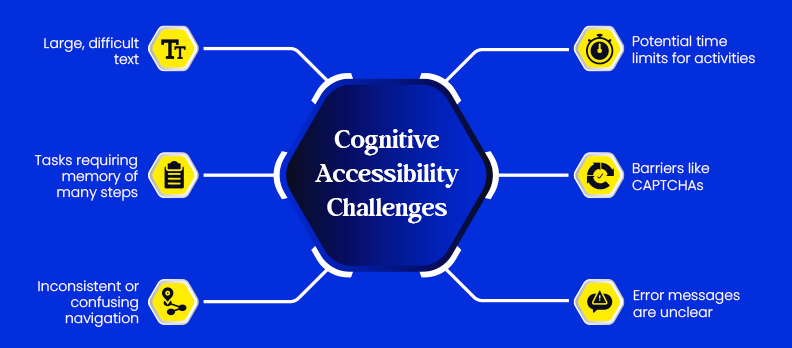
For many individuals with cognitive disabilities, being on a website can be like trying to finish a jigsaw puzzle, but pieces are missing.
Here are some of the challenges they often face online:
Large, difficult text:
Reading walls of dense text filled with technical words or terms that are unfamiliar can be difficult. Even a person without a cognitive disability can be affected by too much complexity and read too quickly to absorb the information.
Tasks requiring memory of many steps:
Completing a long form, following many steps in certain directions, or going through many pages without being reminded can be challenging.
Cognitive challenges with memory not only add to the difficulty, but also the frustration, and sometimes a complete inability to accomplish whatever is the task without assistance.
Inconsistent or confusing navigation:
If menus get moved around, categories/categories get changed, or layouts become inconsistent from one page to another, users easily become lost, and giving them a hint or a breadcrumb can help reassure them. Consistency is a life preserver for many users.
Potential time limits for activities:
Time-limited quizzes, submitting forms that disappear after a certain time, or pop-ups that disappear too quickly, create unwarranted stress and pressure for many people.
For some, it's just not possible to think, figure out, and act in a limited amount of time.
Barriers like CAPTCHAs:
Any tests that require you to identify when images are blurry, count or type when letters are distorted, or follow the many steps in some sort of puzzles, may block access for some users, completely.
For individuals with memory, attention, or visual processing difficulties, these types of tasks often become impossible to complete.
Error messages are unclear:
For example, “Error: Invalid input” does not help the user at all.
If there are no clear, plain-language instructions on what went wrong and how the user can fix it, the user may not know how to resolve the issue and will abandon the task altogether.
Avoiding Common Barriers for People with Cognitive Disabilities
Most barriers faced online can be eliminated, or better, avoided from the outset. Here are some useful ways to remove Cognitive Accessibility barriers:
- Use clear language and short sentences: Write exactly as though you are explaining something to a mate. Use everyday language not jargon and chunk any ideas into smaller, easy to understand pieces of information.
- Keep navigation predictable: In terms of design and layout, menus, buttons and key links need to be in familiar locations on every page. This will reduce the mental effort required to find information and still allow users to navigate by intuition.
- Avoid being unpredictable or using auto-update features: Don’t let pages shift without warning, automatically refresh or jump the user to another section without action from the user. Sudden or unexpected shifts can throw users off and create disorientation and frustration.
- Consider CAPTCHAs and time limits: If you must ask for a CAPTCHA, offer an alternative, such as an audio challenge or simply offer a checkbox. Remove timers on forms or at least offer a means for the user to request more time easily.
- Provide easy, specific error messages: Tell users what happened and what they need to do to fix it, telling a user that they have an "invalid input" is far less useful than telling them, "when you enter your phone number, please use the following format 123-456-7890".
How to Make Website Accessible for People with Cognitive Disabilities?
Although WCAG (Web Content Accessibility Guidelines) are a great starting point, the focus should be on eliminating unnecessary barriers and streamlining the online user experience as much as possible.
Here's how to accomplish that in practice:
1. Flexible Presentation
Ensure information can be experienced in multiple ways without losing meaning. A person utilizing text-to-speech software should get the same information and structural placements as the person viewing the page.
2. Clear Visual Separation
Assist visitors in quickly differentiating between elements. Use color contrast, spacing between sections, and empty-space so the page doesn't feel cluttered.
If an audio file automatically plays, there needs to be an obvious way for the user to pause or stop the audio once the file starts, as any unexpected sound will break concentration.
3. Time Without Pressure
Provide users with room to breath. If not absolutely necessary, remove time limits in the form of strict counts, and if applicable, implement alternatives for users to extend time so they don't feel rushed.
4. Simple and Supported Navigation
- Keep users moving so they don't feel lost.
- Use headings and page titles that are semantically meaningful at a glance,
- Write links that can describe their destination (e.g., "see our accessibility tips" instead of "click here"),
- Provide shortcuts to go to the next repeated block of content,
- Provide breadcrumbs or a site map so visitors can easily retrace their steps.
5. Simple Language
Use everyday language. Avoid industry-specific jargon unless you are able to explain the term in plain language. When possible, spell out the abbreviation the first time you use it.
If you have used any uncommon expressions or sayings, provide a brief explanation about the discussion so that no one is left wondering.
6. Consistency and Predictability
Keep page layouts, button labeling, and order of navigation the same throughout your site. Don't make sudden changes to pages unless the user expects it to be sudden. If a click on the site will create 'the next thing', then state this before the user clicks it.
7. Helpful Forms
When visitors are providing you information, and it is not easy and forgiving:
- Provide as simple directions as possible before they start.
- Let users know that there is a mistake in their form immediately and provide ways to correct it (User experience guidelines relate to this).
- Provide examples of the expected format where possible.
- Provide people with the opportunity to review and confirm their input submission, before final submission of orders, payments, or legal agreements.
Taking cognitive disabilities into account in terms of clarity, flexibility, and predictability creates a digital environment that feels relatable it everyone, even if they don't have a cognitive disability.
How Accesstive Helps Support Cognitive Accessibility
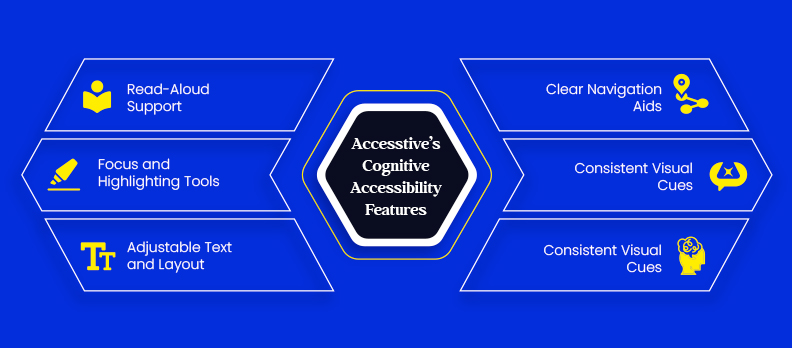
For visitors with memory, attention, reading or comprehension limitations, small design choices can be the difference between feeling included vs. feeling shut out.
Here is how Accesstive's features specifically assist with cognitive accessibility:
1. Read-Aloud Support
Some people best understand information by hearing rather than reading it and the text-to-speech tool will read any page content out loud in real time.
This is helpful to users with dyslexia, ADHD or short-term memory issues to be able to actively follow along without the barriers of decoding text.
2. Focus and Highlighting Tools
Accesstive can highlight part of the page that user is currently reading or working on.
This is particularly helpful for people who lose their place easily, get distracted by elements on a page, and/or feel overwhelmed needing to process everything that is on a page at once and prefer to break it down into sections.
3. Adjustable Text and Layout
For visitors afraid of large blocks of text, Accesstive can change font size, spacing and contrast to make content easier to read. The ability to simplify visuals and eliminate clutter can help pepole take lower cognitive load and better focus.
4. Clear Navigation Aids
Accesstive improves navigation for users by letting them find menus, skip repetitive content, or jump directly to their desired section quickly.
This is important information for people with short-term memory difficulties, who may have trouble keeping mental track of complex paths to navigate.
5. Consistent Visual Cues
Predictability is very important to individuals with cognitive disabilities. Accesstive assures consistent and clear labeling for headings, buttons and other interface elements for better clarity as to what happens when they click or tap.
6. Reduced Distractions
The widget provides options for users to pause or stop animations, flashing items or auto-playing content. Overall, these options can help create a calmer online experience for users with attention and sensory processing differences.
Explore all features here - Accessibility widget
Conclusion
Cognitive disabilities are much more common than people think, and they often go undetected. Making your content accessible is simply about respect, and inclusion, and is good design.
And the reality is, what helps people with cognitive disabilities usually makes it better for everyone, less frustration, faster navigation, and a better overall experience.
If you are not sure how your site measures up, this is a perfect time to find out. We provide a free accessibility audit that will identify the trouble spots and show you precisely what to improve.
It’s an easy first step toward making your website a place where everyone feels included!
FAQs:
Users may get lost if menus, buttons, or page layouts change unexpectedly. Consistent navigation, predictable placement of links, and clear headings reduce confusion and mental effort for everyone.
Highlighting the active section of a page, reducing distractions like auto-play media, and providing clear visual cues help users maintain focus and follow the content without feeling overwhelmed.
Consistency in headings, buttons, and interface elements helps users anticipate outcomes and navigate confidently. Unpredictable layouts increase cognitive load and make tasks harder to complete.
Absolutely. Simplifying language, reducing clutter, and improving navigation benefits everyone by making websites faster to understand, easier to use, and less stressful, improving overall engagement and conversions.
Accesstive offers tools like read-aloud support, focus highlighting, adjustable text and layout, clear navigation aids, consistent visual cues, and options to reduce distractions. These features make websites usable for people with attention, memory, or learning challenges.
Begin by reviewing text clarity, navigation consistency, form usability, and potential barriers like CAPTCHAs or time limits. Tools like Accesstive’s free accessibility audit can identify issues and provide actionable guidance.
Yes. Many improvements, such as simplifying language, adding headings, offering alternative navigation, or providing read-aloud features, enhance usability without altering the visual design.


